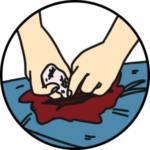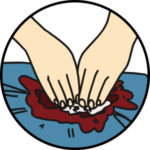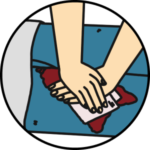Timely medical assistance increases the chances of survival and recovery. Within an hour after an injury, a person should receive qualified medical care. Before this happens, the victim must be given proper premedical care.
Before helping the casualty, make sure that there is no danger to you, and only then proceed to the next step. Approach the person so that he or she can see you: this way the victim will move his or her head less. Speak to the injured person: "Can you hear me? My name is (name). Can I help you?"
Examination of the victim and provision of assistance:
- Find and stop massive bleeding. These are high intensity bleeding conditions that most frequently occur in traumatic amputations, limb or neck injuries. Key signs:
-
- a large spot of blood that continues to grow rapidly;
- blood flowing out of the wound in a pulsating manner;
- intense soaking of clothes with blood.
At the same time, call the paramedics (use the speakerphone) or ask someone to do so.
-
- Free the victim's nose and mouth from foreign objects and liquids. To make breathing easier, tilt the victim's head back: place one hand on the victim's forehead and lift the chin with the fingertips of your other hand. If the person is not breathing, perform indirect heart massage and artificial lung ventilation.
- Once breathing is restored, continue to monitor the person. Single, slow and loud "breaths" are not normal. During the check, you should hear, see or feel the victim's exhalations for 10 seconds. If the person is breathing but unconscious, turn them on their side. Place the victim's upper arm under the head and bend the upper leg so that it presses the knee against the floor. If there is no breathing or it is not normal, start cardiopulmonary resuscitation.
- Examine the chest. Apply a special plaster (if available) with a flap to close the wound – an occlusive sticker.
- Examine the whole body again, treat all wounds, stop even the slightest bleeding.
- Monitor the victim's condition until the medics arrive or ask someone to do so.
- If the victim gets worse, call for emergency medical help again.
- Gather all possible information from the victim or others about the circumstances of the injury, the number of people injured, and their condition, and pass this information on to the medical team.
- If you don't have access to medical assistance, you can contact the police or military.
First aid for blood loss
- Make sure that you are not in danger and that you can provide help to the injured person.
- Put on rubber gloves and, if you have them, protective goggles (make it a rule to take care of your own safety).
- Identify the bleeding area and remove the victim's clothing or free the wound so that you can see it fully.
- Try to stop the bleeding:
- cover the wound with a clean cloth OR put gauze or a clean cloth over the wound;
- apply pressure with both hands OR use a tourniquet (see the instructions below for how to do this correctly).



- Cover the victim and keep an eye on him/her until paramedics arrive.
Basic rules for applying a tourniquet
You can apply a tourniquet to the person next to you or to yourself. Remember: the tourniquet can be used ONLY ONCE. Apply the tourniquet above the wound or as close to the shoulder or hip joint as possible. This can be done both on bare skin and on clothing.
If you apply a tourniquet, first remove anything from the victim's pockets that may prevent the tourniquet from being tightened firmly.
Avoid applying a tourniquet to the knee or elbow, as this will not stop bleeding but may injure the skin around the joint. Tighten the tourniquet until the bleeding stops (as tightly as possible).
Write the hour and minute when the tourniquet was applied on the tourniquet or on the most visible part of the body.
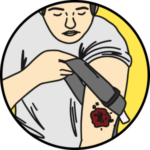
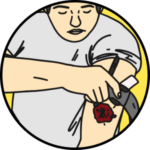
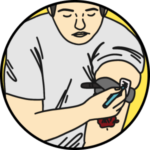
Under NO circumstances should you remove or loosen the tourniquet yourself! Only a medical worker can remove it.

